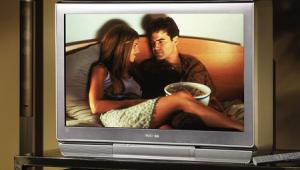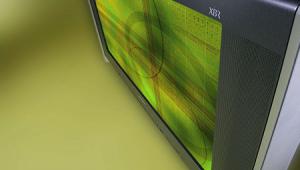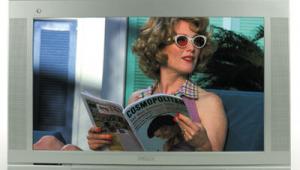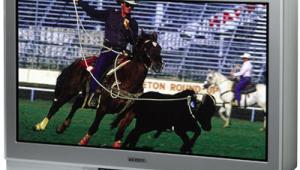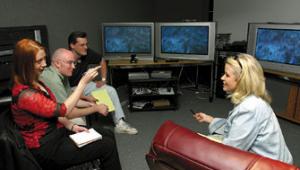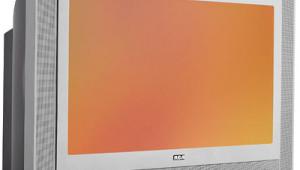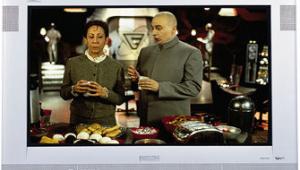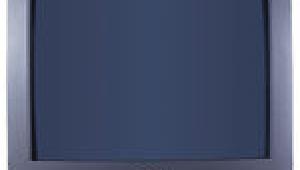The 2002 Direct-View HDTV Face Off Toshiba 34HDX82
In many ways, Toshiba's 34HDX82 was an early favorite to win this Face Off. After all, the company's rear-projection entry kicked some serious butt in the March 2002 RPTV Face Off. Would this set fare as well? Read on to find out.
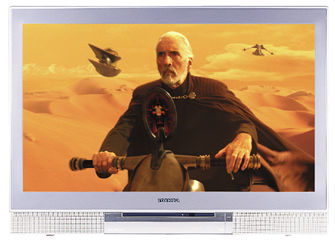
The 34HDX82 is the second of two displays in this competition that offers a DVI input equipped with HDCP. This ensures the set's compatibility with future digital tuners that will include a DVI output and is reason enough to consider this set. Fortunately, Toshiba offers other reasons, like six A/V inputs. These include two wide-bandwidth component (Y/Pb/Pr) connections and a front-panel input that, as with all of the competitors, includes audio, composite, and S-video inputs. There's even a center-channel input on back, so you can utilize the TV's front speakers as your surround system's center channel. It's not an idea we endorse; but hey, options are always good.
 Speaking of options, the Toshiba also allows you to fine-tune the picture parameters for each input. This is a good option that isn't available on many TVs. The only downside is that you have to save your settings manually with the save function. If your memory is like mine and you forget this step, you may have to adjust the controls a couple of times. Then again, it's good to know that your friends and relatives can't accidentally disturb your carefully calibrated settings. The rest of the colorful, well-marked menu system is equally easy to navigate. In fact, this was the only TV that offered discrete commands for source and power functions.
Speaking of options, the Toshiba also allows you to fine-tune the picture parameters for each input. This is a good option that isn't available on many TVs. The only downside is that you have to save your settings manually with the save function. If your memory is like mine and you forget this step, you may have to adjust the controls a couple of times. Then again, it's good to know that your friends and relatives can't accidentally disturb your carefully calibrated settings. The rest of the colorful, well-marked menu system is equally easy to navigate. In fact, this was the only TV that offered discrete commands for source and power functions.
The remote control, on the other hand, received mixed reviews. Claire loved the blue backlighting. While she found the color to be attractive, the fact that it was backlit at all seemed to be the biggest bonus. Maureen and Geoffrey weren't too jazzed about the numerous small buttons packed closely together. As I was the one who set up the various displays, I had no problem using it. Geoffrey admitted that the Toshiba remote was the only one worthy of a high-end digital display. The other remotes, he felt, were just too wimpy.
 Using the remote and the onscreen menu functions, you can fine-tune the picture controls to your taste. In fact, thanks to the fleshtone control, the set has one of the most accurate color decoders as adjusted by the manufacturer. This circuit allows you to modify the color decoder to your liking. With this function switched off (and before professional calibration), I found that this set presented one of the most natural-looking images of the bunch. The variable SVM function helps, too. If you like SVM's enhanced but distorted look, you can turn it on; if not, turn it off. Chris appreciated the image's detail level when the SVM was off. The Toshiba's DC restoration was also good, keeping dark images dark regardless of the rest of the picture. Ron, Geoffrey, and I, however, complained about the set's surprisingly high black level. Even with the brightness control set to an accurate level (or even lower), the darkest parts of the picture were never as dark as they were on the other displays. This was particularly noticeable with Denzel Washington's face and shirt during the opening diner scene in Training Day. In a bright room, this wouldn't be an issue. In a darkened theater, though, it takes away from the image's perceived depth.
Using the remote and the onscreen menu functions, you can fine-tune the picture controls to your taste. In fact, thanks to the fleshtone control, the set has one of the most accurate color decoders as adjusted by the manufacturer. This circuit allows you to modify the color decoder to your liking. With this function switched off (and before professional calibration), I found that this set presented one of the most natural-looking images of the bunch. The variable SVM function helps, too. If you like SVM's enhanced but distorted look, you can turn it on; if not, turn it off. Chris appreciated the image's detail level when the SVM was off. The Toshiba's DC restoration was also good, keeping dark images dark regardless of the rest of the picture. Ron, Geoffrey, and I, however, complained about the set's surprisingly high black level. Even with the brightness control set to an accurate level (or even lower), the darkest parts of the picture were never as dark as they were on the other displays. This was particularly noticeable with Denzel Washington's face and shirt during the opening diner scene in Training Day. In a bright room, this wouldn't be an issue. In a darkened theater, though, it takes away from the image's perceived depth.
Otherwise, the 34HDX82 performed well. Maureen and Claire both felt that the Toshiba and Sony displays were comparably detailed—less so than the Philips but more so than the Zenith. With HD images, Maureen even suggested that the Toshiba and the Sony were nearly indistinguishable. Ron and I both appreciated the Toshiba's slightly better before-calibration colorimetry, which offered natural, neutral-looking fleshtones but still kept other images vibrant.
We also welcomed the 34HDX82's excellent video processing. Granted, the video processor was too slow to pick up our test DVD's constantly disrupted 3:2 sequence, but it compensates for the sequence eventually. As long as your source doesn't break the sequence like a commercial does, the processor will eliminate the motion artifacts that are visible with film-based video sources. Otherwise, you may see a quick hiccup. Fortunately, the display's Y/Pb/Pr inputs accept 480p signals from a progressive-scan DVD player or external line doubler. Better still, the TV retains full control of this input's aspect ratio. Unfortunately, the TV doesn't automatically detect anamorphically recorded DVDs. You have to switch the aspect ratio yourself.
While the 34HDX82 may not have ranked first, Toshiba makes a strong entry whose accuracy is second only to the Sony display after it has been calibrated. Otherwise, the out-of-the-box 34HDX82 would rank number one. It's not perfect, though, and some of these faults may have led our panel of esteemed judges to look at some of the other contenders, perhaps more than they should have. You may have to check out the 34HDX82 for yourself to decide.

34HDX82 HD Monitor $2,700
Toshiba America Consumer Products
(800) 631-3811
www.toshiba.com/tacp
Dealer Locator Code TOS
Highlights
• Accurate color decoder with little adjustment
HT Labs Measures: Toshiba 34HDX82
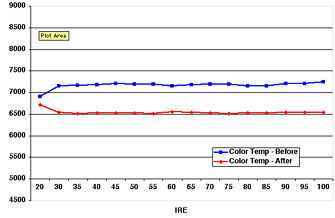
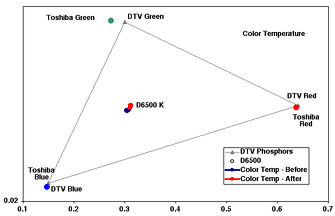
The top chart shows the gray scale of the 34HDX82 HD monitor as set by the manufacturer in the most accurate color-temperature menu setting. The set measures 7,300 Kelvin across most of the range. After making adjustments using the Photo Research PR-650, the gray scale measures within 50 degrees of D6500, the accurate setting, across most of the range, only drifting upwards to 6,700 K with extremely dark images. The bottom chart shows that the primary colors of the display's CRTs are extremely close to those specified by SMPTE. This means that the display will accurately reproduce nearly all of the colors available in the system. The gray scale measures only mildly blue before calibration and is extremely accurate afterward. The light output was approximately 16 foot-lamberts. The display has good DC restoration. The set's color decoder is accurate, and the set displays about 1,150 horizontal pixels with the 1080i test pattern from our Leader LT-446 HDTV test-pattern generator.—MW
